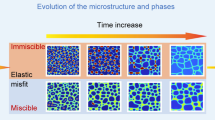Abstract
There is compelling evidence for the critical role of twin boundaries (TBs) in imparting the extraordinary combination of strength and ductility to nanotwinned metals. Here, we investigate the thermal fluctuations of TBs in face-centered-cubic metals to elucidate the deformation mechanisms governing their kinetic properties using molecular dynamics simulations. Our results show that the TB motion is strongly coupled to shear deformation up to 0.95 homologous temperature. A rather unexpected observation is that coherent TBs do not exhibit any capillarityinduced fluctuations even at high temperatures, in sharp contrast to other high-angle grain boundaries.




Similar content being viewed by others
References
L. Lu, Y. Shen, X. Chen, L. Qian, and K. Lu: Ultrahigh strength and high electrical conductivity in copper. Science 304, 422 (2004).
A.M. Hodge, Y.M. Wang, and T.W. Barbee Jr.: Mechanical deformation of high-purity sputter-deposited nano-twinned copper. Scr. Mater. 59, 163 (2008).
D. Jang, X. Li, H. Gao, and J.R. Greer: Deformation mechanisms in nanotwinned metal nanopillars. Nature Nanotech. 7, 594 (2012).
A.J. Cao, Y.G. Wei, and X.S. Mao: Deformation mechanisms of face-centered-cubic metal nanowires with twin boundaries. Appl. Phys. Lett. 90, 151909 (2007).
R.J. Asaro and Y. Kulkarni: Are rate sensitivity and strength effected by cross-slip in nano-twinned FCC metals. Scr. Mater. 58, 389 (2008).
T. Zhu, J. Li, A. Samanta, H.G. Kim, and S. Suresh: Interfacial plasticity governs strain rate sensitivity and ductility in nanostructured metals. Proc. Natl. Acad. Sci. USA 104 (2007).
M. Dao, L. Lu, R.J. Asaro, J.T.M. De Hossan, and E. Ma Li: Toward a quantitative understanding of mechanical behavior of nanocrystalline metals. Acta Mater. 55, 4041 (2007).
D. Wolf, V. Yamakov, S.R. Phillpot, A. Mukherjee, and H. Gleiter: Deformation of nanocrystalline materials by molecular-dynamics simulation: relationship to experiments? Acta Mater. 53, 1 (2005).
K. Zhang, J.R. Weertman, and J.A. Eastman: Rapid stress-driven grain coarsening in nanocrystalline Cu at ambient and cryogenic temperatures. Appl. Phys. Lett. 87, 061921 (2005).
F. Sansoz and V. Dupont: Grain growth behavior at absolute zero during nanocrystalline metal indentation. Appl. Phys. Lett. 89, 111901 (2006).
X. Li, Y. Wei, W. Yang, and H. Gao: Competing grain boundary and dislocation mediated mechanisms in plastic strain recovery in nanocrystalline aluminum. Proc. Natl. Acad. Sci. USA 106, 16108 (2009).
C.J. Shute, B.D. Myers, S. Xie, T.W. Barbee Jr., A.M. Hodge, and J.R. Weertman: Detwinning, damage and crack initiation during cyclic loading of Cu samples containing aligned nanotwins. Scr. Mater. 60, 1073 (2011).
C.J. Bezares, S. Jiao, Y. Liuc, D. Bufford, L. Lu, X. Zhang, Y. Kulkarni, and R.J. Asaro: Indentation of Nano-Twinned FCC Metals: Implications for Nano-Twin Stability. Acta Mater. 60, 4623 (2012).
S.A. Safran: Statistical Thermodynamics of Surfaces, Interface, and Membranes (Westview Press, Colorado, USA, 2003).
J.J. Hoyt, Z.T. Trautt, and M. Upmanyu: Fluctuation in molecular dynamics simulation. Math. Comput. Simul. 80, 1382 (2010).
A. Karma, Z.T. Trautt, and Y. Mishin: Relationship between equilibrium fluctuations and shear-coupled motion of grain boundaries. Phys. Rev. Lett. 109, 095501 (2012).
S.J. Plimpton: Fast parallel algorithms for short-range molecular dynamics. J. Comput. Phys. 117, 1 (1995).
Y. Mishin, M.J. Mehl, D.A. Papaconstantopoulos, A.F. Voter, and J.D. Kress: Structural stability and lattice defects in copper: ab initio, tight-binding, and embedded atom calculations. Phys. Rev. B 63, 224106 (2001).
J.J. Hoty, M. Asta, A. Karma: Method for computing the anisotropy of the solid- liquid interfacial free energy. Phys. Rev. Lett. 86, 5530 (2001).
Z.T. Trautt and M. Upmanyu: Direct two-dimensional calculations of grain boundary stiffness. Scr. Mater. 86, 5530 (2001).
S.M. Foiles and J.J. Hoyt: Computation of grain boundary stiffness and mobility from boundary fluctuations. Acta Mater. 54, 3351 (2006).
J.J. Hoyt, Z.T. Trautt, and M. Upmanyu: Interface mobility from interface random walk. Science 314, 632 (2006).
C. Rottman: Thermal fluctuation in low-angle grain boundary. Acta Metall. 34, 2465 (1986).
J.W. Cahn, Y. Mishin, and A. Suzuki: Coupling grain boundary motion to shear deformation. Acta Mater. 54, 4953 (2006).
T. Sinha and Y. Kulkarni: Anomalous deformation twinning in fcc metals at high temperatures. J. Appl. Phys. 109, 114315 (2011).
ACKNOWLEDGMENTS
The authors would like to acknowledge the support of the US National Science Foundation under grants DMR-1006876 and CMMI-1129041 and the Defense Advanced Research Projects Agency under grant N66001-10-1-4033. Yashashree Kulkarni would like to thank Professor Pradeep Sharma, University of Houston, for stimulating discussions. The simulations were performed on the supercomputing facility hosted by the Research Computing Center at University of Houston.
Author information
Authors and Affiliations
Corresponding author
Rights and permissions
About this article
Cite this article
Chen, D., Kulkarni, Y. Elucidating the kinetics of twin boundaries from thermal fluctuations. MRS Communications 3, 241–244 (2013). https://doi.org/10.1557/mrc.2013.37
Received:
Accepted:
Published:
Issue Date:
DOI: https://doi.org/10.1557/mrc.2013.37




